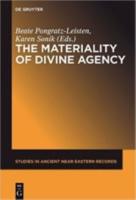
De Gruyter (2015) h/b 239pp £74.99 (ISBN 9781501510687)
The relationship between people and objects has been at the centre of many recent studies, with a range of so-called ‘New Materialisms’ seeking to counter Cartesian dichotomies between mind and body, subject and object, person and thing. Some of these theories are undoubtedly crazier than others. But what they have in common is that they usefully propagate what Jane Bennett has called ‘attentiveness to things’. This edited volume contributes to such attentiveness by isolating a particularly captivating question: when considering the relationship between people and things, what do we do with the gods? The volume’s contributors set to work on this question through a series of case studies, focusing on the ancient Near East though looking also to ancient Greece and medieval Europe. The convergence of themes is timely, engaging with a burgeoning scholarly field that stretches from philosophy to anthropology and sweeps classics and archaeology along with it.
The issue that seems to differentiate one New Materialism from the next is one that is of crucial importance to this volume: that of agency. The initial chapter by the volume’s editors does much to establish a theoretical and methodological framework for the whole, defining and unpacking terms like materiality and presence, agency and anthropomorphism. Agency is particularly relevant to consideration of sacred things—how are we to understand objects that are said to have been products of divine rather than human hands? How do sacred things act, and to what extent do they act independently? How is divine agency distributed through (for example) statues, temples and relics? P-L. and S. do a particularly good job of disentangling ideas of primary and secondary agency (pp.17-24), a debate at the heart of various ‘Thing’ theories. They make the astute observation that, while ‘we differentiate the divine from its secondary agents for the purposes of objective or at least external analysis’, we have to be aware of the ‘human conflation’ between the source of power and its material mediators (p.21). This surely is an important point to remember when considering the divine, and indeed religions more generally: that objective analysis and human perception are rarely one and the same.
S.’s chapter on ‘Divine (Re-)Presentation: Authoritative Images and a Pictorial Stream of Tradition in Mesopotamia’ (pp.142-93), complete with pictures, is worth highlighting as one with applicability beyond its case study (the ninth century BC Sun God Tablet from Sippar). It explores the relationship between anthropomorphised images of the divine and their divine referent. To pick out one interesting detail from many, S. notes of depictions of the goddess Ishtar that, through various attributes, she is somehow portrayed as more than human, without crossing the boundaries of the anthropomorphic body—a commitment to the human form that contrasts with, for instance, Egyptian depictions of the divine. The chapter then examines tradition as a means of establishing the authority of divine images. S. notes that deliberately archaising features can perform this function, connecting an image with predecessors on which it ostensibly claims to have been modelled, and looking back even to ‘a real or imagined original initiated or at least approved in the divine sphere.’ One is reminded of Homeric objects like Agamemnon’s sceptre or Odysseus’ bow, imbued with power and authority by value of their noble lineage and, ultimately, divine creation.
Not all of the questions raised in this book will be of interest to the student, and certainly not with this kind of price tag. Not all of the six case studies will be pertinent to any one course. And yet, the charm of many of the essays lies in their attention to the memorable detail. I, for one, will not soon forget the craftsmen who have their hands severed with a tamarisk wood sword in a disavowal of human agency behind the creation of a cult statue (p. 9), or the woman who stole a piece of altar bread to bury under her keg so that people would prefer to drink her beer (p.74).
Dr Lilah Grace Canevaro—The University of Edinburgh
